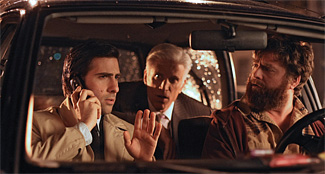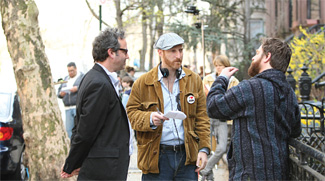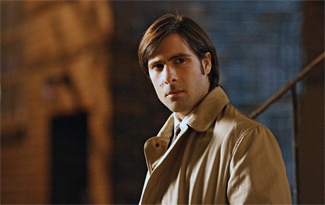Film Noir Goes Digital
HOLLYWOOD
HBO's narrative series have almost always been shot on film, but the cable network has dipped a toe into the world of digital cinematography for the eight-episode (plus pilot) season of series "Bored to Death," even though one of the producers' key visual requirements was that the film noir-inspired series have a "filmic" look.

Jonathan (Jason Schwartzman), Ray (Zach Galifianakis) and George (Ted Danson) watch for action in a motel room. The show stars Jason Schwartzman as a writer whose character shares the name and some characteristics with show creator Jonathan Ames. The fictional Ames goes into something of a tailspin after his girlfriend leaves him, and he decides to moonlight as the kind of private detective he's always admired in movies and novels.
Cinematographer Vanja Cernjul, who shot the pilot and the season of "Bored to Death" with the digital camera, was glad to be charged with making the series look like it originated on film since most of his work, including a significant chunk of the NBC series "30 Rock," was shot on film. In fact, Cernjul's entrée into the world of series television came about relatively recently, when he was hired to shoot the pilot for "Ugly Betty" with no TV work on his resume at all specifically because the producers wanted an "indie film" look and he had several films that year getting noticed in the festival circuit.
Both that pilot and "30 Rock" were film shows; his experience with HD was fairly limited. "When I got the job on 'Bored to Death,'" he recalls, "I knew the producers wanted to shoot in HD, but there was also this connection to older film noir and so it was important to have a film-like look. I had worked briefly with the D-21 before and I was very happy with what the images looked like right out of the camera."
OUT OF FOCUS
Cernjul definitely wanted to go with the larger, 35mm-sized sensor and the attendant smaller depth of field rather than anything with a 2/3-inch chip. This decision was made for aesthetic as well as practical reasons, he recounts. "I really like the look of letting the background go out of focus," he says. "It's also something people recognize as the look of film. The Master Prime lenses we used are just really gorgeous when they go out of focus, too. But when you're on a TV schedule and shooting locations, it can really help to be able to throw the background out of focus."
Cernjul also appreciated the D-21's optical viewfinder, which many competing cameras don't offer. "This is a location-based show and we're moving around a lot," he says. "I like to use the viewfinder to start lighting, and I don't want to wait for the camera or monitors to be set up and turned on. The optical viewfinder was very important to me on this show."

Michael Lehmann, executive producer/writer Jonathan Ames and Zach Galifianakis on the set. Cernjul explains that the show's looks essentially define the Ames' character's two worlds, both in an internal and geographical sense. As a writer who's poured over Raymond Chandler books and knows many old detective films perhaps too well, Jonathan's environment in Brooklyn, where he lives, looks and feels rather warm and fairly realistic, while Manhattan—the location of much of his detective work—takes on a cold and often exaggerated feel that reflects his state of mind.
"When [the real] Jonathan Ames described the character Jonathan Ames to me," Cernjul recalls, "he said he was kind of like Don Quixote, and the reference helped me a lot. Because when we played with film noir elements, we didn't want it to feel like a caricature of the genre. We wanted the reality of New York to cater to his fantasy but still look believable."
Director of the pilot Alan Taylor, Cernjul clarifies, didn't want to go for the actual low-key, monochromatic style that characterizes the look people associate with film noir. "We went in the opposite direction," he says. "Look at the posters from those films, the advertisements. They went with strong colors and high contrast. And we did that, too—strong primary colors. But we wanted to motivate the look, say with neon lights on people's faces."
Much of this material takes place at night, and Production Designer Rick Butler would find ways to put neon into a lot of the setups. "We really found the look of the show on the pilot, when the Jonathan character is standing in front of a hotel where he's staking someone out," says Cernjul. "We wet down the street and created the look of neon reflections and vapor light motivated by streetlights and another look for car headlights, and when he walks into the interior, you have still different light sources inside, all based on the idea of the film noir poster art. I really didn't go to extremes in mixing different colored light in the city at night, but it might look that way. If you really go out with your digital camera and take pictures in the street at night, people's skin tones will take on the color of different light sources, but often as a cinematographer you want to sort of 'clean it up.' But here it was the perfect look."
PUSHING THE ENVELOPE

After a breakup, Jonathan idly decides to offers his services as a private detective on Craigslist. Of course, the preponderance of night work pushed the D-21 in an area that even the camera's biggest fans admit could stand some improvement: its effective speed. Cernjul rated the camera at EI 200 and pushed the gain where needed to be able to treat it more like 320. "That's really as far as you can go with the D-21," says the cinematographer, who pretty much had to make whatever light was going to read for night exteriors. "I would have liked to have been able to push [the gain] some more. It would have been nice to get some 'extra' New York street for free."
Cernjul began by lighting to a light meter as he would for a film show, but he took the meter out less and less as work progressed. "You can use a meter as orientation," he says, "but it's hard to use a meter for contrast because it reacts so differently than film does if you're working with more or less light [than key]. I used the monitors and scopes a little bit, but primarily I trained my eye to be able to light for the camera."
Cernjul credits DIT (Digital Imaging Technician) Nicholas Kay with helping him focus on the look and creativity rather than technical details of the sensor. "I really believe in that position," he says. "I could work more like I would on a film show—spending time on the set rather than with the monitors—and I always knew someone was taking care of everything else."
The cinematographer says he's found working on "Bored to Death" creatively very rewarding. "It's the most interesting work I've done in TV," he said. "On '30 Rock,' I was able to create a lot of different kinds of looks, especially in the flashbacks and fantasies, but it was more theatrical. You didn't have to think about motivation for color. In this, I made sure I had a good reason for every color we used. The style on 'Bored to Death' is really an essential part of the story, which is why I've loved working on it so much."
Get the TV Tech Newsletter
The professional video industry's #1 source for news, trends and product and tech information. Sign up below.
